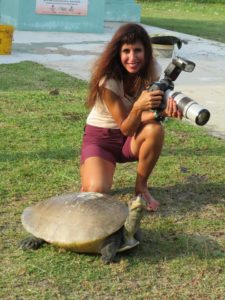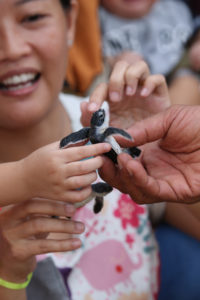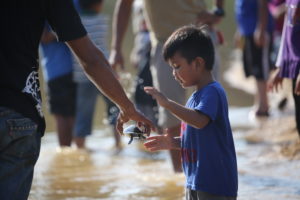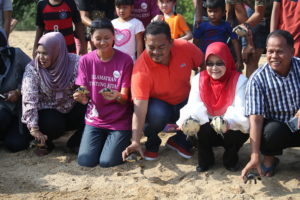Vera Nieuwenhuis’ Photos Help Bring Awareness To Endangered Turtles
River terrapins are considered a critically endangered freshwater turtle species, mostly due to human consumption and habitat destruction. The Turtle Conservation Society of Malaysia (TCS) is a non-governmental organization (NGO) that is working hard to reverse and/or eliminate this unfortunate trend.
Our Vera Nieuwenhuis’ impactful images are helping TCS to spread the “word.”

Vera Nieuwenhuis
Each year, Photographers Without Borders (PWB) connects volunteer photographers like Vera to grassroots initiatives like TCS. The goal: through photographs and videos, causes like these are shown to the world, and seen, as the website says, “through a new lens.”
“Photographers Without Borders will send you to a part of the world where they are trying to send a message,” Vera says. “You can photodocument the process of that message. It’s meaningful. The photos need to tell a story, saying, ‘there’s a message here.’”
The competition for PWB opportunities is intense, and, if chosen for a project, it becomes a once-in-a-lifetime experience, perhaps even history-making.
“I’ve been applying to them for years,” she says, “putting in an application for a number of projects.”
Once she was chosen, Vera traveled alone, with no team.
“Malaysia was really far,” she says, “but it was really fantastic.”
In order to get to Malaysia, Vera turned to friends and social media to raise money for program expenses, as well as airfare (about $800 roundtrip, and 26 hours each way). Also accounted for: a $20/night hotel in the small town of Chukai, located in the east coast state of Terengganu.

A new hatchling sea turtle about to enter the Red China Sea is held by locals at Cherating Turtle Sanctuary. Photo by Vera Nieuwenhuis.
Malaysia is a Muslim-dominated country, and all religious laws there must be respected. For women, that means being clothed from head to toe.
“It was about 90-100 degrees, and I had to make sure that I was covered,” Vera says. “I was meeting with schools and organizations, so I didn’t want to offend. It was so hot! They were the kindest people, and they came from such humble means. Most of them spoke English, which made it really easy.”
On average, she took about 700-800 photos a day, and then narrowed it down to the best 100 shots. The photos are then presented to audiences at all different levels: universities, elementary schools, and civic organizations. That’s yet another way Vera was able to personally interact with both the Chinese and Muslim cultures.
“My job over there was two weeks of just documenting daily events of TCS’ turtle research and conservation efforts,” she says. “We would go to a school every week and we would educate them. This is why it’s important — bringing awareness to what we can do about it.”
The United Nations has outlined top environmental concerns in its U.N. Sustainable Development Goals. Nonprofits and initiatives involved in the cause must be grassroots; they must be in need; and they must be addressing the interconnected problems facing the planet.

Photo by Vera Nieuwenhuis
TCS met all of these requirements, and chose Vera to tell the story with her camera and her vision.
“I’ve been shooting for about five years as a professional photographer,” she says. “Mostly I shoot sports, but then I broadened. So I learned a lot of different facets of photography, from real estate to product.”
With PWB, Vera would receive an accelerated crash course in photojournalism — and activism.
“The chronic consumption of turtle eggs is a problem over there,” Vera says. “People actually like to eat them; it’s considered a loal delicacy. Statistics show that only one hatchling in approximately five thousand turtle eggs would survive to adulthood. Additionally, some locals also consume turtle meat (not the Muslims though). The idea is to get people to become more aware of this so that they can be more cognizant of it. The turtles will become extinct soon if we continue to do these things.”
The biggest event happened on Vera’s last day — the releasing of the 300 head-started critically endangered freshwater turtles back into the river, also called the Terrapin Independence Day. In February, during the nesting season, terrapin eggs were secured for incubation. The hatchlings began to emerge in May, and they were head-started in captivity. In September, the hatchlings were released into the Kemaman River, in an attempt to repopulate the river with a species that was once in abundance — a cause for celebration. This event was also documented by two local newspapers in the country: Sinar Harian and the New Straits Times.

Photo by Vera Nieuwenhuis
Since the river terrapin conservation project was initiated in 2012, TCS and the local community have saved more than 4,500 terrapin eggs from human consumption, and released more than 2,700 terrapin juveniles into the river.
“You shoot and try to capture what it is you see as the message,” Vera says, “so that is what I think I accomplished.”
Click here to donate to the work of Photographers Without Borders.
Click here to donate to The Turtle Conservation Society of Malaysia.
